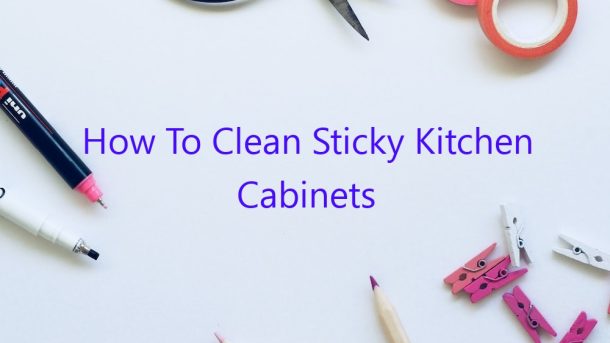If your kitchen cabinets are sticky, it can be difficult to clean them properly and remove all the dirt and grime. However, with the right method and some helpful tips, you can have your kitchen cabinets looking and smelling fresh in no time.
The first step is to gather the supplies that you will need. You will need a cleaning solution, a sponge, a cloth, and a toothbrush. You can either make your own cleaning solution or purchase a commercial product. If you choose to make your own, mix 1/4 cup of baking soda with 1 cup of warm water.
The next step is to clean the cabinets. Wet the sponge in the cleaning solution and wipe down the cabinets. Be sure to pay special attention to the areas that are sticky. If there is any dirt or grime, use the toothbrush to scrub it away.
Once the cabinets are clean, dry them off with the cloth. If you want to give them a fresh smell, you can also spray them with a light coating of furniture polish.
That’s all there is to it! By following these simple steps, you can have your kitchen cabinets looking and smelling like new.
Contents
Why do my kitchen cabinets feel sticky?
If your kitchen cabinets feel sticky, it could be the result of a build-up of grease and dirt. This can be caused by cooking oils and fats, as well as dust and dirt from everyday use. Over time, this build-up can make your cabinets feel sticky and dirty.
There are a few things you can do to help reduce the build-up of grease and dirt on your cabinets. First, try to clean your cabinets regularly with a damp cloth. This will help remove any dirt and dust that has built up. You can also try using a degreaser to remove any cooking oils or fats.
If your cabinets still feel sticky after cleaning them, you may need to take a more aggressive approach. You can try using a stronger cleaner, such as an ammonia-based cleaner or a cabinet cleaner. Be sure to follow the instructions carefully and avoid getting any of the cleaner on your skin.
If your cabinets are still sticky after cleaning them, you may need to consider refinishing them. This can be a time-consuming process, but it can be worth it if your cabinets are in bad condition.
Ultimately, the best way to keep your cabinets from feeling sticky is to keep them clean. Clean them regularly with a damp cloth, and use a degreaser or stronger cleaner if necessary. If your cabinets are in bad condition, consider refinishing them.
What is the best degreaser for kitchen cabinets?
If you’re like most homeowners, you probably don’t think about cleaning your kitchen cabinets until they start to look a little dirty. And even then, it’s probably not high on your list of priorities. But the fact is, kitchen cabinets need to be cleaned on a regular basis, just like any other surface in your home.
One of the best ways to clean kitchen cabinets is with a degreaser. But with so many degreasers on the market, it can be difficult to know which one is the best for your needs. Here is a look at some of the most popular degreasers on the market and what to consider when choosing one.
1. Simple Green
Simple Green is a popular all-purpose degreaser that can be used on a variety of surfaces, including kitchen cabinets. It is non-toxic, biodegradable, and non-flammable, making it a safe choice for use around the home. Simple Green can be purchased in both liquid and spray form, and it is effective at removing grease, dirt, and grime.
2. citrus degreasers
If you are looking for a degreaser that is derived from natural ingredients, citrus degreasers are a good option. These degreasers are made from orange and lemon peels, and they work by breaking down the oils and fats that are found in dirt and grime. Citrus degreasers are safe to use around pets and children, and they are also biodegradable.
3. ammonia-based degreasers
Ammonia-based degreasers are some of the most effective degreasers on the market. They are effective at removing grease, dirt, and grime, and they also have a disinfecting effect. However, ammonia-based degreasers can be toxic and should be used with caution. They should not be used around pets or children, and they should never be mixed with other cleaning products.
When choosing a degreaser for your kitchen cabinets, it is important to consider the specific needs of your home. If you are looking for a safe and biodegradable degreaser, citrus degreasers are a good choice. If you are looking for a powerful degreaser that can tackle tough dirt and grime, ammonia-based degreasers are a good option.
How do you clean kitchen cabinets without removing the finish?
There are a few ways that you can clean your kitchen cabinets without removing the finish. The first is to use a vinegar and water solution. You can either mix the vinegar and water together in a spray bottle and then spray it on the cabinets, or you can soak a rag in the solution and then wipe the cabinets down. The vinegar will help to remove any dirt or grime that is on the cabinets, and it will also help to disinfect them.
Another way to clean your cabinets without removing the finish is to use a baking soda and water solution. You can either mix the baking soda and water together in a spray bottle and then spray it on the cabinets, or you can soak a rag in the solution and then wipe the cabinets down. The baking soda will help to remove any dirt or grime that is on the cabinets, and it will also help to disinfect them.
The third way to clean your cabinets without removing the finish is to use a mild soap and water solution. You can either mix the soap and water together in a spray bottle and then spray it on the cabinets, or you can soak a rag in the solution and then wipe the cabinets down. The soap will help to remove any dirt or grime that is on the cabinets, and it will also help to disinfect them.
How do you clean sticky laminate cabinets?
Laminate cabinets can be a great addition to any kitchen, but they can also be a pain to clean. If they get sticky, it can be difficult to get the gunk off. Here are a few tips on how to clean your sticky laminate cabinets.
The first step is to gather all of the supplies that you will need. This includes a dishcloth, a non-abrasive cleaner, and a bowl of hot water.
The next step is to spray the cleaner onto the dishcloth and wipe down the cabinets. Make sure to pay special attention to the areas that are sticky.
Once the cabinets are clean, rinse them off with the bowl of hot water. This will help remove any leftover cleaner and will leave your cabinets looking shiny and new.
If you follow these simple steps, your sticky laminate cabinets will be clean in no time!
Can I use magic eraser on kitchen cabinets?
Can you use a magic eraser on kitchen cabinets?
Yes, a magic eraser can be used on kitchen cabinets, but it is not recommended. The eraser can remove the finish from the cabinets and leave them with a dull appearance. If you do choose to use a magic eraser on your kitchen cabinets, be sure to test it in an inconspicuous area first to make sure it does not remove the finish.
How do you fix a sticky wood finish?
There are a few ways that you can fix a sticky wood finish. One way is to use a cloth to apply a tiny amount of mineral oil to the finish. Be sure to use a very small amount, as too much oil can make the finish too slick. Another way is to use a candle to apply a tiny amount of wax to the finish. Be sure to use a very small amount, as too much wax can also make the finish too slick.
Can you use Dawn dish soap on wood cabinets?
Can you use Dawn dish soap on wood cabinets?
Yes, Dawn dish soap can be used on wood cabinets; however, you should always test it in a small, inconspicuous area to make sure it does not harm the finish. Dawn dish soap is a good choice for cleaning wood cabinets because it is a degreasing agent and it will remove any dirt or grease buildup.




